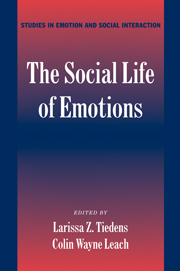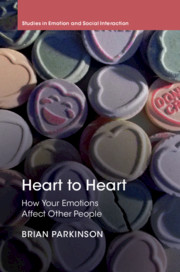Communicating Emotion
Social, Moral, and Cultural Processes
$87.00 (C)
Part of Studies in Emotion and Social Interaction
- Author: Sally Planalp, University of Montana
- Date Published: August 1999
- availability: Available
- format: Hardback
- isbn: 9780521553155
$
87.00
(C)
Hardback
Other available formats:
Paperback, eBook
Looking for an examination copy?
This title is not currently available for examination. However, if you are interested in the title for your course we can consider offering an examination copy. To register your interest please contact [email protected] providing details of the course you are teaching.
-
The central argument of this book is that emotion is meaningful and meaning is emotional. The modern world is forcing us to understand emotion in order to cope with new problems such as road rage and epidemic levels of depression, as well as age-old problems such as homicide, genocide and racial tension. This book draws on scholarly research to address, explain and legitimize the role that emotion plays in everyday interaction and in many of the pressing social, moral, and cultural issues that we face today.
Read more- This book addresses commonly held myths that emotion is irrational, incommunicable, authentic, personal, amoral and universal
- It draws together research from several disciplines to bear on issues related to communicating emotion
- It addresses basic issues involved in communicating emotion
Reviews & endorsements
"...this is a thought-provoking book, rich in the issues that are taken up and in the perspectives considered." Nico H. Frijda, Contemporary Psychology
See more reviews"...well-reasoned and appropriately qualified. I would suggest Planalp's Communicating Emotion, as a first read for anyone seeking to learn more about emotion and communication. It is unique in its ability to pull together for the Communication scholar diverse and complex literatures in an accurate and readable fashion....[Planalp's] book does insure that future researchers in this area will proceed with a clear understanding of the complex tapestry that are trying to unravel." Mark Knapp, Quarterly Journal of Speech
"Communicating Emotion is a cleverly-crafted and beautifully-written book that draws on a number of disciplines including psychology, communication studies, anthropology, philosophy, and even management, in an attempt to bring order to, and make sense of, the literature on human emotion and emotional behavior." Julie Fitness, Journal of Social and Personal Relationships
"Anyone interested in the field of emotion communication...will gain clarity as well as valuable information from this book. In addition, it is a pleasure to read. Planalp writes in a lively, mobile style and with an appealing moral involvement in the topic." Contemporary Psychology
Customer reviews
Not yet reviewed
Be the first to review
Review was not posted due to profanity
×Product details
- Date Published: August 1999
- format: Hardback
- isbn: 9780521553155
- length: 316 pages
- dimensions: 237 x 159 x 26 mm
- weight: 0.607kg
- availability: Available
Table of Contents
1. How important is emotion in everyday life?
2. How much skill is involved in communicating emotion?
3. Is emotional communication spontaneous or strategic?
4. How is emotional meaning constructed through communication?
5. How is emotional meaning both personal and social?
6. How do emotion messages communicate moral meaning?
7. How is emotional communication founded in common human experience and diverse cultures?
Sorry, this resource is locked
Please register or sign in to request access. If you are having problems accessing these resources please email [email protected]
Register Sign in» Proceed
You are now leaving the Cambridge University Press website. Your eBook purchase and download will be completed by our partner www.ebooks.com. Please see the permission section of the www.ebooks.com catalogue page for details of the print & copy limits on our eBooks.
Continue ×Are you sure you want to delete your account?
This cannot be undone.
Thank you for your feedback which will help us improve our service.
If you requested a response, we will make sure to get back to you shortly.
×










